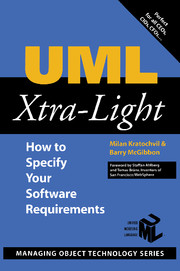Book contents
- Frontmatter
- Contents
- Foreword
- Preface
- Acknowledgments
- About the Authors
- How to Customize This Book
- Chapter 1 Introduction
- Chapter 2 Aligning to the Business
- Chapter 3 Adding Rigor to the Requirements
- Chapter 4 Sketching the Inside Structure
- Chapter 5 Sketching the Inside Dynamics
- Chapter 6 Moving Toward Components
- Chapter 7 Mapping from Classes to Data Models
- Chapter 8 Concluding Remarks
- Some Suggested Readings
- Index
Foreword
Published online by Cambridge University Press: 14 October 2009
- Frontmatter
- Contents
- Foreword
- Preface
- Acknowledgments
- About the Authors
- How to Customize This Book
- Chapter 1 Introduction
- Chapter 2 Aligning to the Business
- Chapter 3 Adding Rigor to the Requirements
- Chapter 4 Sketching the Inside Structure
- Chapter 5 Sketching the Inside Dynamics
- Chapter 6 Moving Toward Components
- Chapter 7 Mapping from Classes to Data Models
- Chapter 8 Concluding Remarks
- Some Suggested Readings
- Index
Summary
Yet another book about UML! Since its initial version, the Unified Modeling Language has gone an impressive way in the IT community. Over the past couple of years, we have been loading our bookcase with quite a few UML books. Many of them deal with applying or extending UML for a specific domain: UML for project management, UML for business modeling, UML for Java, real-time UML, UML for components, UML for web applications, and so forth.
This book takes a somewhat different and, in our opinion, long-awaited approach. It goes back to the basics of UML: improving the communication among different stakeholders of a (software) project. As the authors of the book write: “a UML made easy for people who specify, buy, or manage complex software systems”. Many of these stakeholders are non-IT professionals in much need of an easy-to-digest introduction to UML.
Looking back on the IBM SanFrancisco project – one of the real success projects in the field of object-oriented business applications – where we, at IBS, played a central role as initiators and principal development partner to IBM, a key success factor was the alignment among domain experts, sponsors, and object experts – through a minimum set of concepts and techniques.
In addition, this book focuses on the new paradigm in software development: fast delivery of applications based on components sourced from various suppliers.
- Type
- Chapter
- Information
- UML Xtra-LightHow to Specify Your Software Requirements, pp. ix - xPublisher: Cambridge University PressPrint publication year: 2002

